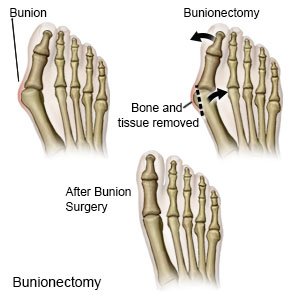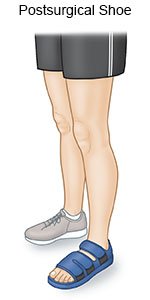Bunionectomy
Medically reviewed by Drugs.com. Last updated on Apr 6, 2025.
What do I need to know about bunionectomy?
A bunionectomy is surgery to remove the bunion and bring your big toe back into its correct position. Bones, tendons, nerves, or ligaments may also be moved or put into the correct position.
 |
How do I prepare for bunionectomy?
Your healthcare provider will talk to you about how to prepare for surgery. He or she may tell you not to eat or drink anything after midnight on the day of your surgery. He or she will tell you what medicines to take or not take on the day of your surgery. You may be given an antibiotic through your IV to help prevent a bacterial infection. Arrange for someone to drive you home and stay with you to make sure you are okay.
What will happen during bunionectomy?
- You may get anesthesia to numb your foot or numb your leg from the knee down. You may instead get spinal anesthesia to numb you below the waist. With these types of anesthesia, you may feel pressure or pushing, but you should not feel any pain. General anesthesia is sometimes used to keep you completely asleep.
- Your surgeon will make an incision on the top, side of, or below the bunion. You may need more than 1 incision. Extra bone and tissue may be removed. Your surgeon may make small cuts in the bones to place the bones in the correct position. He or she may instead remove the bunion and line up the bones. The ligament (strong tissue) that has tightened and pulled the toe inward may be cut to help make the toe straight again. In some cases, you may need to have your toe joint rebuilt or repaired. Pins, screws, wires, or plates may be placed in your toe joint to hold it in place. The incision is then closed with stitches and covered with a bandage.
What will happen after bunionectomy?
You will usually be able to go home after bunionectomy. You may have a toe spacer to hold your toe in place for up to 6 weeks while your foot heals. You may need to wear a post surgical shoe for up to 6 weeks after surgery. You may need crutches or a walker if you cannot put weight on your foot. You may have a brace or cast while your toe heals.
 |
What are the risks of bunionectomy?
- You may bleed more than expected or get an infection. The nerves in your foot may be damaged during surgery. You may continue to have pain. You may have stiffness in your toe joint and your big toe may not line up with your other toes. Your bones may not fully heal. Your bunion may return. You may get a blood clot in your leg. This may become life-threatening.
- It may take up to 6 months to return to your usual activities. Your foot may have some swelling for up to 1 year after bunionectomy. You may not be able to wear heels or small or narrow pointed shoes again.
Care Agreement
You have the right to help plan your care. Learn about your health condition and how it may be treated. Discuss treatment options with your healthcare providers to decide what care you want to receive. You always have the right to refuse treatment. The above information is an educational aid only. It is not intended as medical advice for individual conditions or treatments. Talk to your doctor, nurse or pharmacist before following any medical regimen to see if it is safe and effective for you.© Copyright Merative 2025 Information is for End User's use only and may not be sold, redistributed or otherwise used for commercial purposes.
Further information
Always consult your healthcare provider to ensure the information displayed on this page applies to your personal circumstances.
